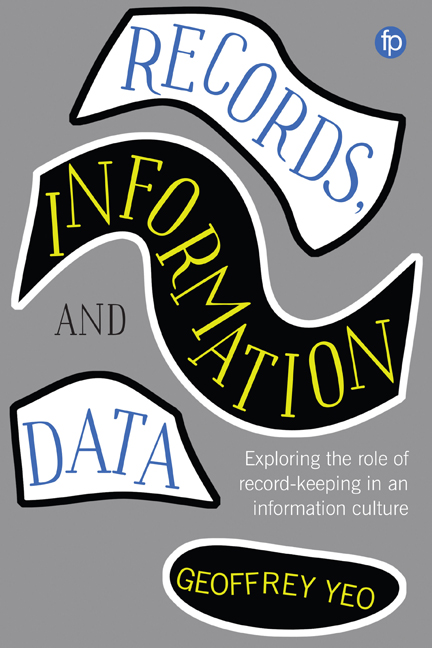Book contents
- Frontmatter
- Contents
- Introduction
- 1 The Making and Keeping of Records: a Brief Historical Overview
- 2 Thinking About Records and Archives; the Transition to the Digital
- 3 Archivists, Records Managers and the Rise of Information
- 4 Finding a Way Through the Hall of Mirrors: Concepts of Information
- 5 Records and Data
- 6 Representation, Performativity and Social Action: Why Records Are Not (Just) Information
- 7 Managing Information or Managing Records?
- Concluding Thoughts: Record-Keeping Present and Future
- Index
2 - Thinking About Records and Archives; the Transition to the Digital
Published online by Cambridge University Press: 24 September 2019
- Frontmatter
- Contents
- Introduction
- 1 The Making and Keeping of Records: a Brief Historical Overview
- 2 Thinking About Records and Archives; the Transition to the Digital
- 3 Archivists, Records Managers and the Rise of Information
- 4 Finding a Way Through the Hall of Mirrors: Concepts of Information
- 5 Records and Data
- 6 Representation, Performativity and Social Action: Why Records Are Not (Just) Information
- 7 Managing Information or Managing Records?
- Concluding Thoughts: Record-Keeping Present and Future
- Index
Summary
Introduction
If archivists or records managers in the early 21st century were asked to conjure up a mental picture of a record, most would probably think of a unit of written text. Textual records have long been at the heart of archival endeavour, and archival institutions now hold vast numbers of them. Conceptually, however, records cannot be confined to textual domains. Particularly in preliterate or semi-literate societies – as the previous chapter suggested – records have often taken the form of three-dimensional artefacts. Drawings, sketches and visual charts can record what happened in the past, and static photographic images have come to fulfil a similar role. Archival scholar Anne Gilliland (2017, 54) has noted how physical artefacts and visual depictions can serve record-keeping needs for those deprived of other means of recording, as in the case of the cloth arpilleras woven by women in 20thcentury Chile to document their experiences under a repressive government. In contemporary societies, records can also include moving images and sound recordings; video recordings of a meeting or conference, and audio recordings of an interview or telephone conversation, are all recognisable as records of the events concerned. Nevertheless, for most records professionals, these are not the examples that immediately come to mind when the concept of a ‘record’ is under discussion; in professional discourse, records and written text often seem to belong together. Using terminology developed in the 1970s by psychologist Eleanor Rosch, we may say that – for most archivists and records managers in contemporary western societies – a ‘prototypical’ record is largely or wholly textual.
American psychologist Eleanor Rosch developed ‘prototype theory’ as a means of understanding human approaches to categorisation (Rosch, 1978; Smith and Medin, 1981). Rosch and her associates suggested that most conceptual categories have prototypes, which are usually envisaged as mental mappings of typical features: for example, having feathers, an ability to fly and a propensity to build nests might be typical features of a member of the category of ‘birds’. A prototype of a bird is likely to be a mental composite of features such as these.
Prototype theory affirms that category membership is graded, and that candidates for membership of a category are assessed in terms of their similarity to a mental prototype.
- Type
- Chapter
- Information
- Records, Information and DataExploring the Role of Record Keeping in an Information Culture, pp. 29 - 60Publisher: FacetPrint publication year: 2018



